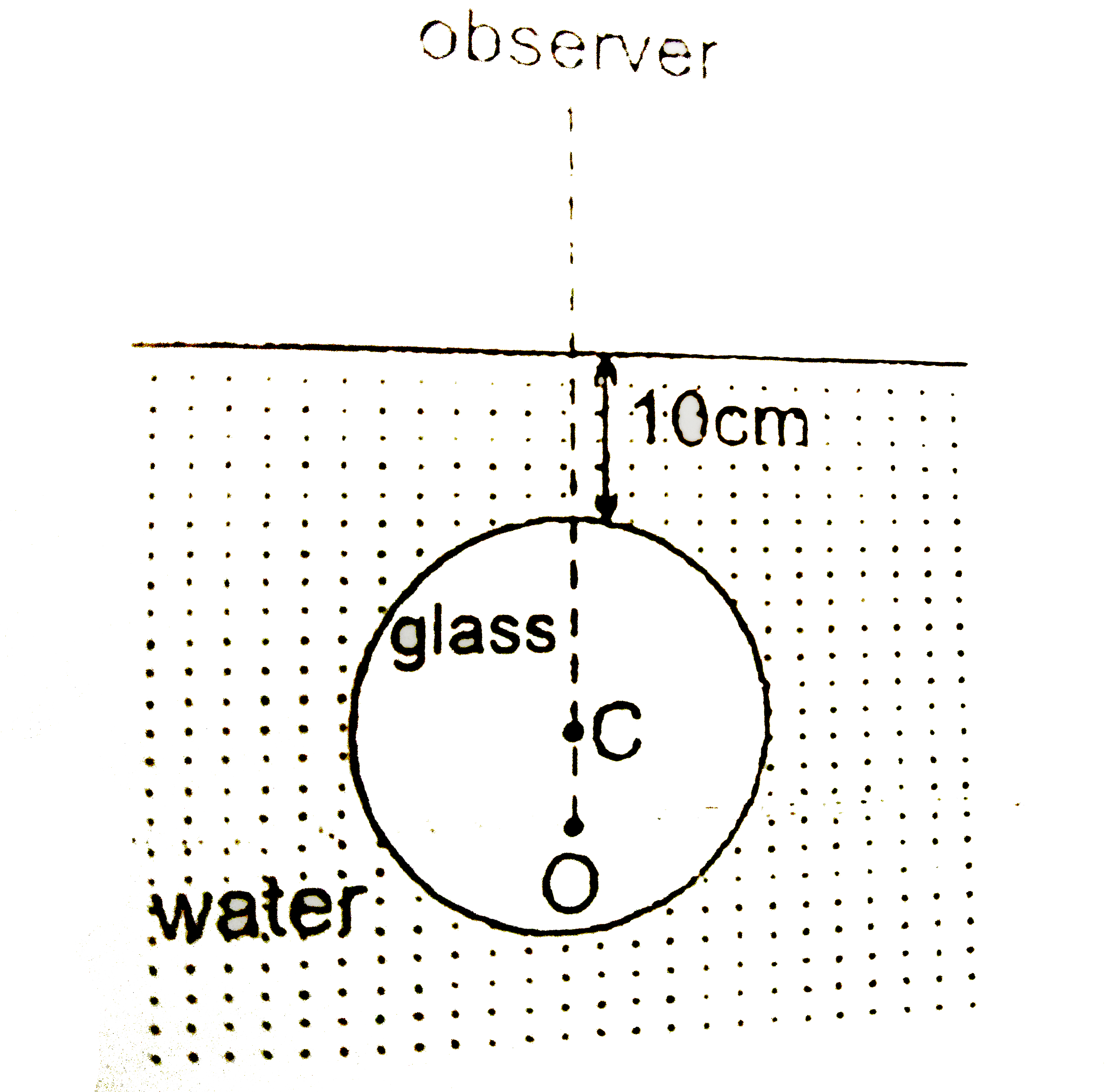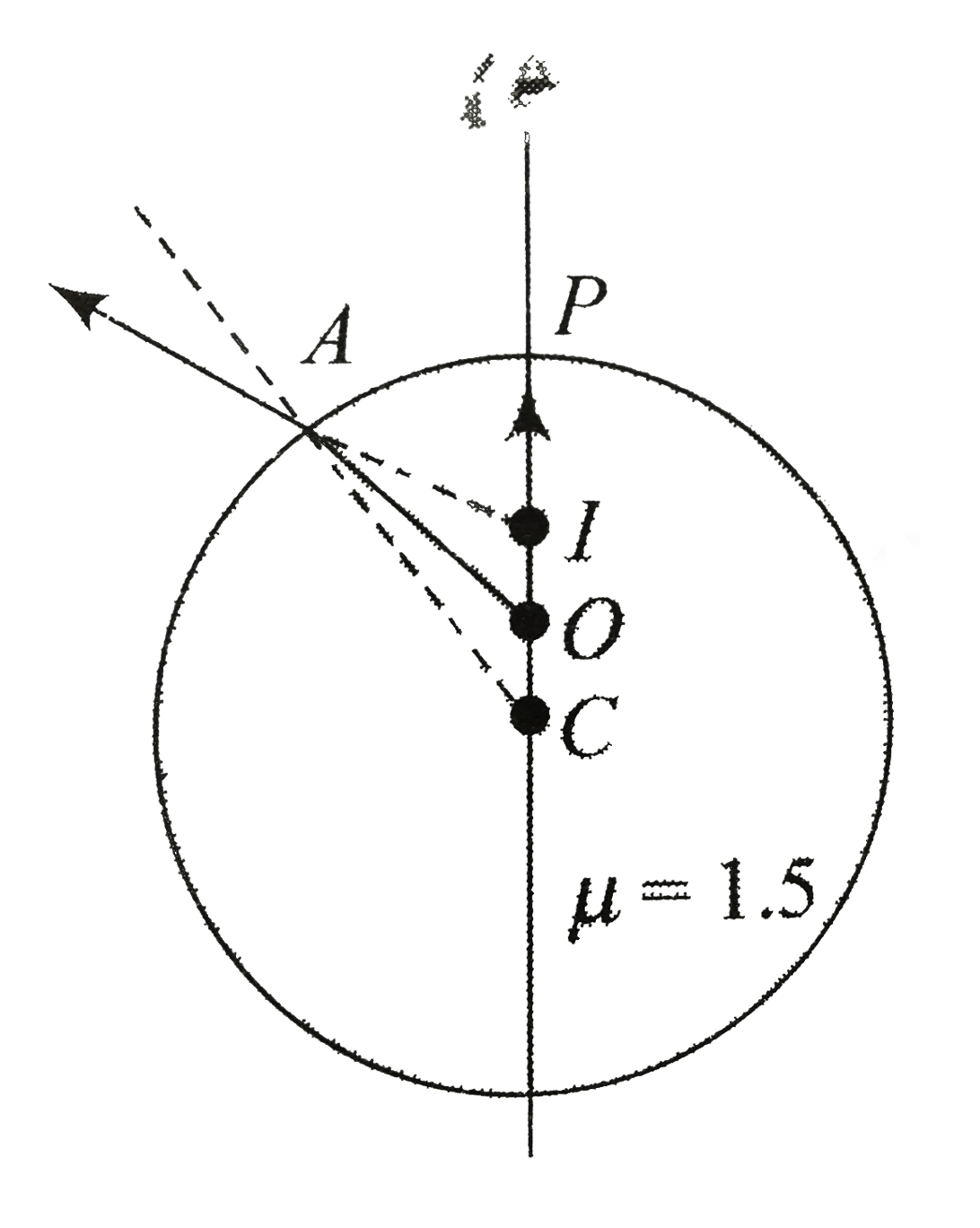A glass sphere of (μ=1.5) with a radius of 15.0cm has a tiny air bubble 5cm above its centre. The sphere is viewed looking down along the extended radius containing the bubble. What is the apparent depth of the bubble below the surface of the sphere?
The correct Answer is:C
To find the apparent depth of the bubble below the surface of the glass sphere, we can follow these steps:
Step 1: Identify the Given Values
- Refractive index of glass, μ1=1.5
- Refractive index of air, μ2=1
- Radius of the sphere, R=15.0cm
- Distance of the bubble above the center, OA=5.0cm
Step 2: Calculate the Distance from the Center to the Bubble
The distance from the center of the sphere (point O) to the bubble (point A) is given as OA=5.0cm. Therefore, the distance from the center to the bottom of the sphere (point B) is:
OB=R−OA=15.0cm−5.0cm=10.0cm
Step 3: Set Up the Sign Convention
According to the sign convention:
- Distances measured upwards (towards the observer) are positive.
- Distances measured downwards (away from the observer) are negative.
Since the bubble is below the surface of the sphere, we take U=−OB=−10.0cm.
Step 4: Use the Formula for Apparent Depth
The formula we will use is:
μ2V−μ1U=μ2−μ1R
Substituting the known values:
1V−1.5−10=1−1.515
This simplifies to:
1V+1.510=−0.515
Step 5: Solve for 1V
Convert the fractions:
1V+0.15=−0.0333
Now, isolate 1V:
1V=−0.0333−0.15=−0.1833
Step 6: Calculate V
Taking the reciprocal gives:
V=1−0.1833≈−5.46cm
Step 7: Interpret the Result
Since the value of V is negative, it indicates that the apparent depth of the bubble below the surface of the sphere is approximately 5.46cm.
Final Answer
The apparent depth of the bubble below the surface of the sphere is approximately 8.57cm.
---
- Refractive index of glass, μ1=1.5
- Refractive index of air, μ2=1
- Radius of the sphere, R=15.0cm
- Distance of the bubble above the center, OA=5.0cm
The distance from the center of the sphere (point O) to the bubble (point A) is given as OA=5.0cm. Therefore, the distance from the center to the bottom of the sphere (point B) is:
OB=R−OA=15.0cm−5.0cm=10.0cm
According to the sign convention:
- Distances measured upwards (towards the observer) are positive.
- Distances measured downwards (away from the observer) are negative.
The formula we will use is:
μ2V−μ1U=μ2−μ1R
Substituting the known values:
1V−1.5−10=1−1.515
This simplifies to:
1V+1.510=−0.515
Convert the fractions:
1V+0.15=−0.0333
Now, isolate 1V:
1V=−0.0333−0.15=−0.1833
Taking the reciprocal gives:
V=1−0.1833≈−5.46cm
Since the value of V is negative, it indicates that the apparent depth of the bubble below the surface of the sphere is approximately 5.46cm.
The apparent depth of the bubble below the surface of the sphere is approximately 8.57cm.
Topper's Solved these Questions
- BOOK - DC PANDEY ENGLISHCHAPTER - REFRACTION OF LIGHTEXERCISE - Exercise 31.612videos
REFRACTION OF LIGHT
- BOOK - DC PANDEY ENGLISHCHAPTER - REFRACTION OF LIGHTEXERCISE - Exercise 31.72videos
REFRACTION OF LIGHT
- BOOK - DC PANDEY ENGLISHCHAPTER - REFRACTION OF LIGHTEXERCISE - Exercise 31.41videos
REFRACTION OF LIGHT
- BOOK - DC PANDEY ENGLISHCHAPTER - REFLECTION OF LIGHTEXERCISE - Subjective9videos
REFLECTION OF LIGHT
- BOOK - DC PANDEY ENGLISHCHAPTER - SEMICONDUCTORSEXERCISE - Subjective12videos
SEMICONDUCTORS
Similar Questions
A glass sphere (μ=1.5) of radius 20 cm has a small air bubble 4 cm below its centre. The sphere is viewed from outside and along a vertical line through the bubble. The apparent depth of the bubble below the surface of sphere is (in cm)
View SolutionA glass sphere of radius 5 cm has a small bubble at a distance 2 cm from its centre.The bubble is viewed along a Diameter of the sphere from the side on which it lies.How far from the surface will it appear.Refractive index of glass is 1.5
2.5 cm behind the surfaceView SolutionA sphere (μ=43) of radius 1m has a small cavity of diameter 1cm at its centre. An observer who is looking at it from tight, sees the magnification of diameter of the cavity as
View SolutionThere is small air bubble inside a glass sphere (μ=1.5) of radius 5cm. The bubble is at 'O' at 7.5cm below the surface of the glass. The sphere is placed inside water (μ=43) such that the top surface of glass is 10cm below the surface of water. The bubble is viewed normally from air. Find the apperent depth of the bubble.
 View Solution
View SolutionA glass sphere of diameter 50 cm and μ=1.5 has a small air bubble. Looking from outside the diameter, the bubble appears to be at a distance 10 cm the surface. Find the apparent position of the bubble when it is viewed from the diametrically opposite position.
View SolutionA small object is embedded in a glass sphere (mu =1.5) of radius 5.0 cm at a distance 1.5 cm left to the centre. Locate the image of the object as seen by an observer standing (a) to the left of the sphere and (b) to the right of the sphere.
View SolutionThere is a small air bubble inside a glass sphere (μ=1.5) of radius 10 cm. The bubble is 4.0cm below the surface and is viewd normally from the outside. Find the apparent dipth of the bubble.
 View Solution
View SolutionA glass hemisphere of radius 10cm and μ=1.5 is silvered over its curved surface. There is an air bubble in the glass 5cms from the plane surface along the axis. Find the position of the images of this bubble seen by observer looking along the axis into the flat surface of the atmosphere.
View SolutionThe radius of a sphere is 1.23 cm. What is its surface area?
View SolutionAn air bubble is seen inside a solid sphere of glass (n=1.5) of 4.0cm diameter at a distance of 1.0cm from the surface of the sphere (on seeing along the diameter). Determine the real position of the bubble inside the sphere.
View Solution

